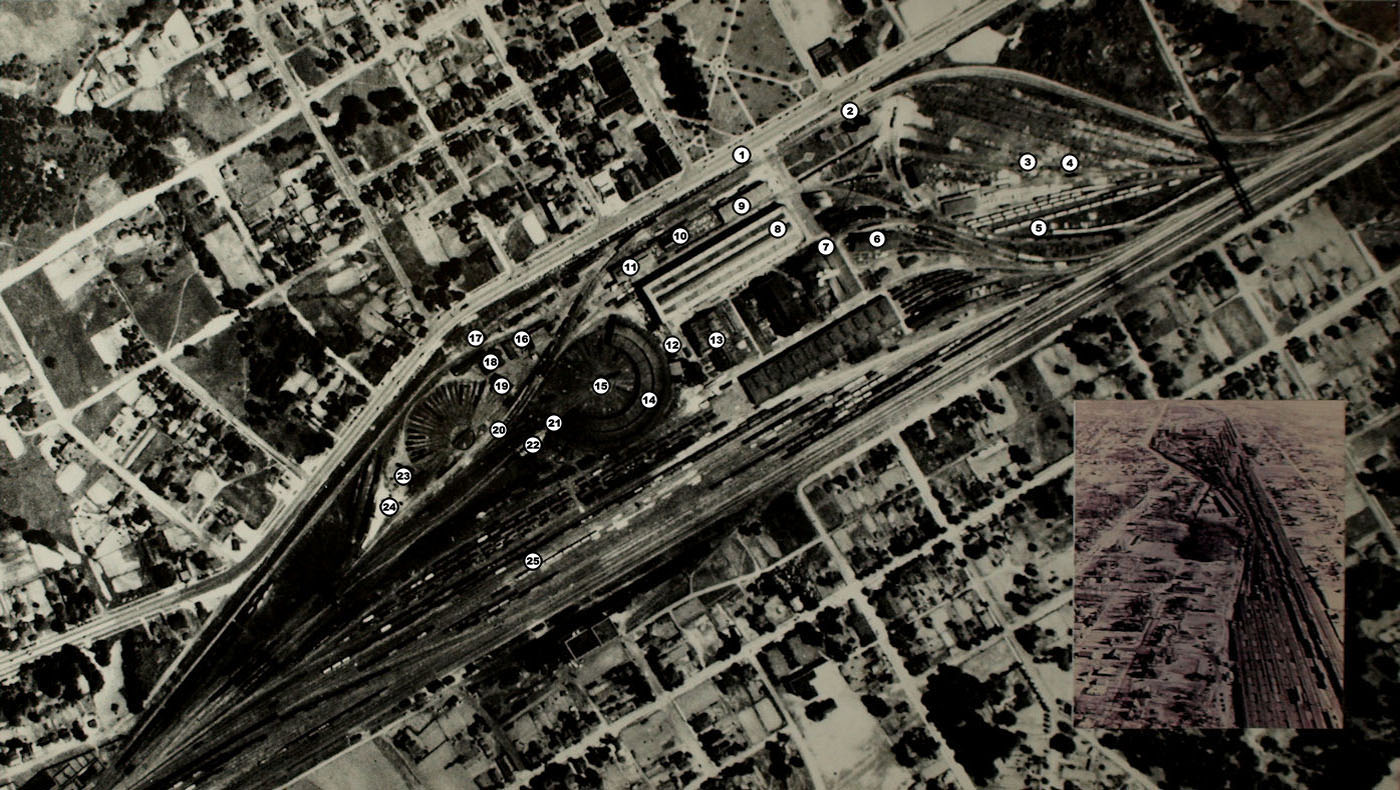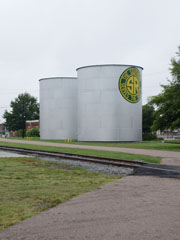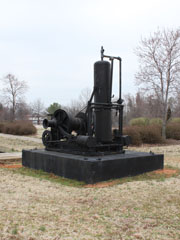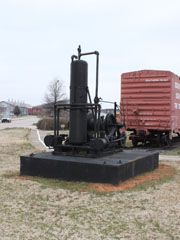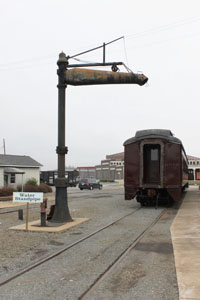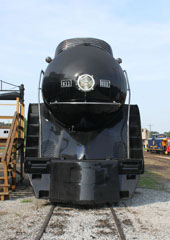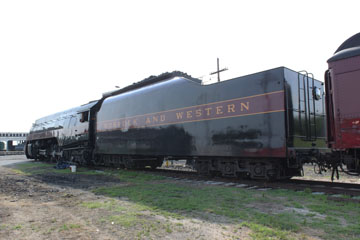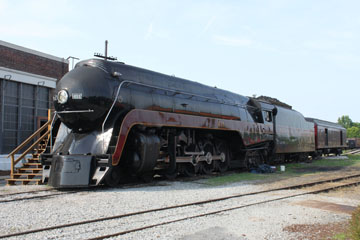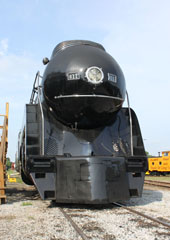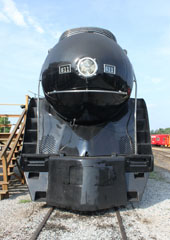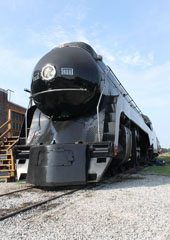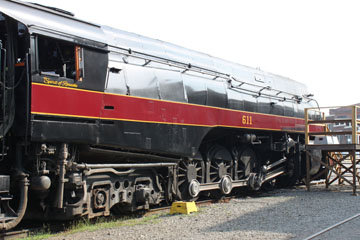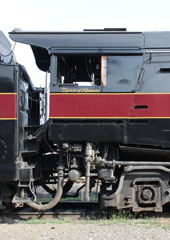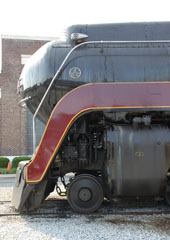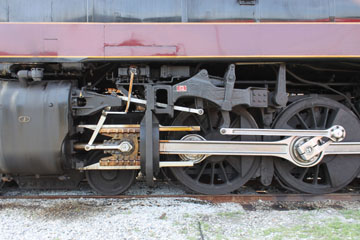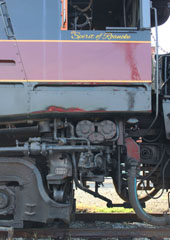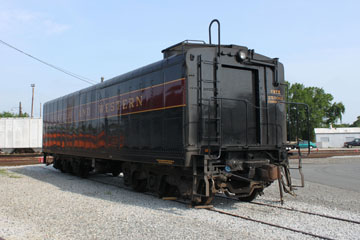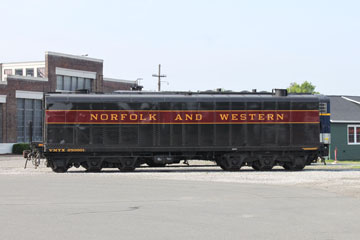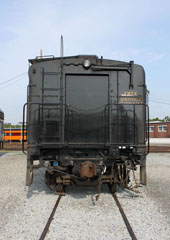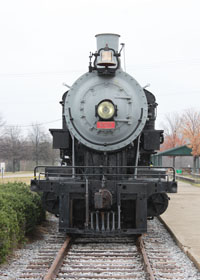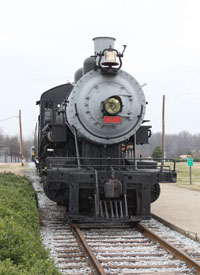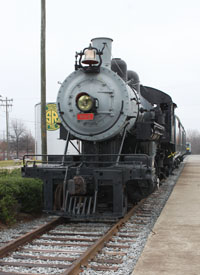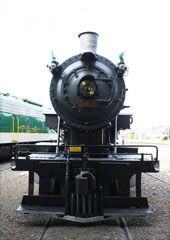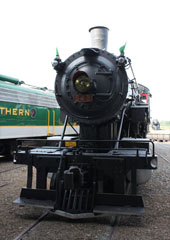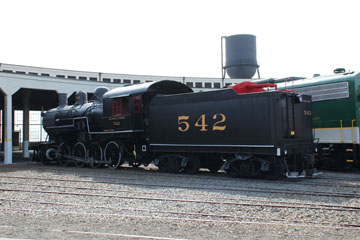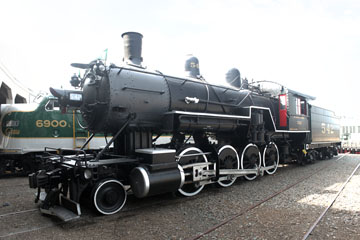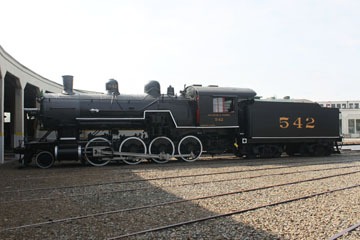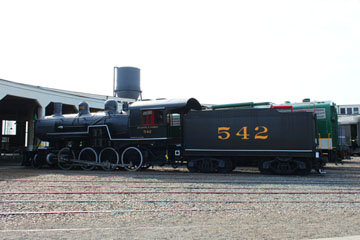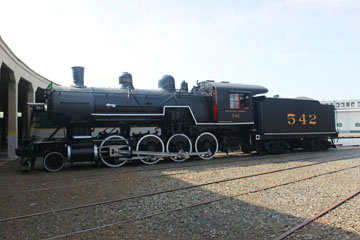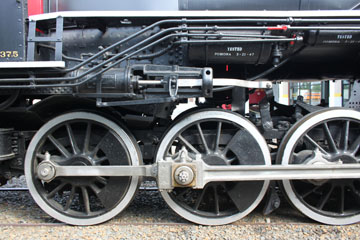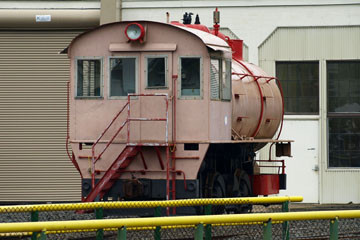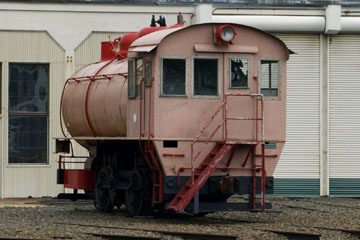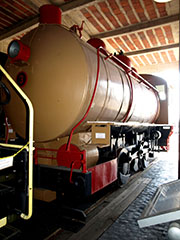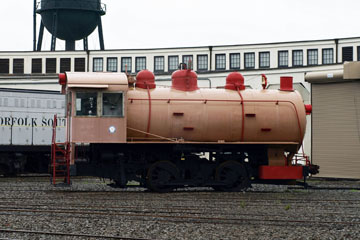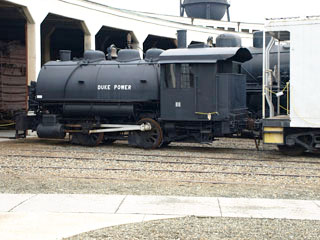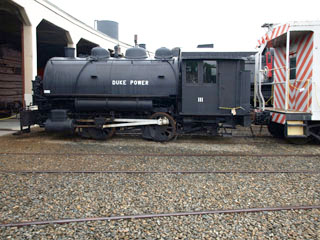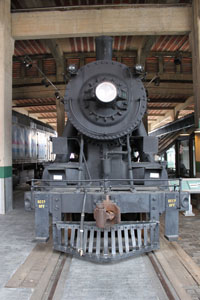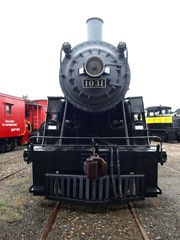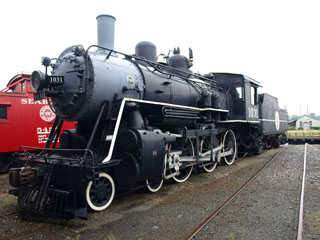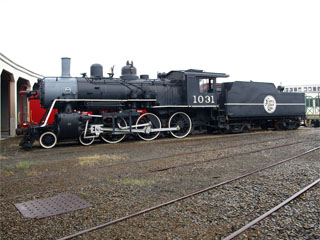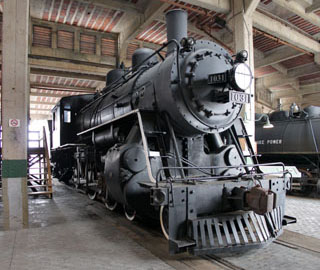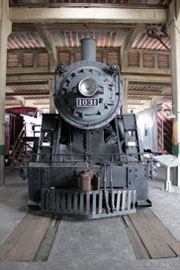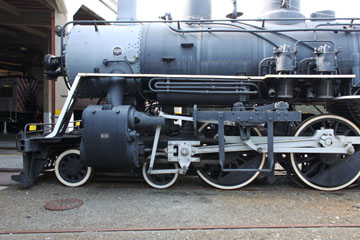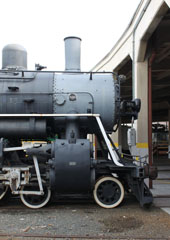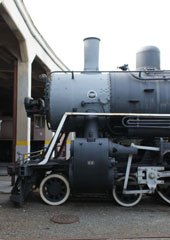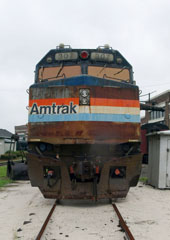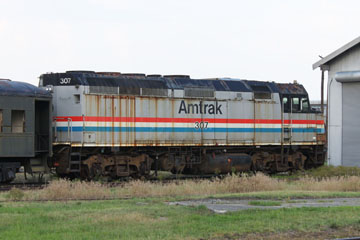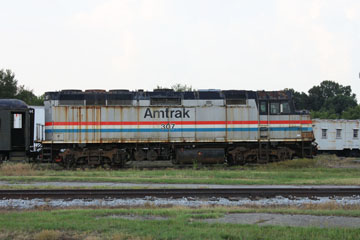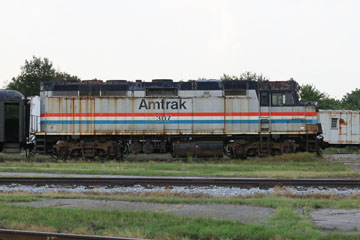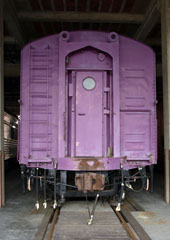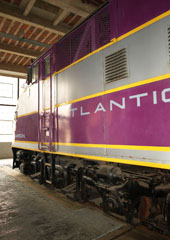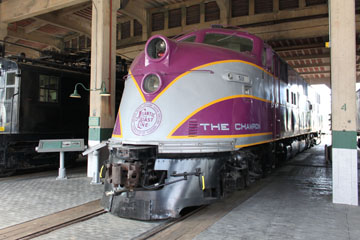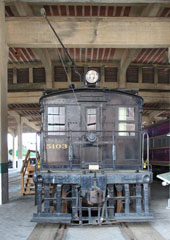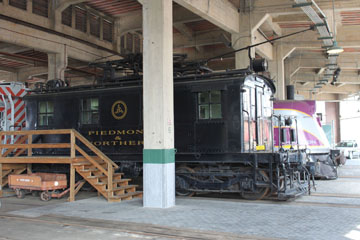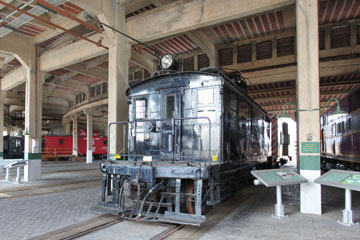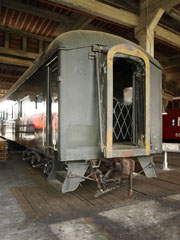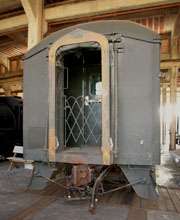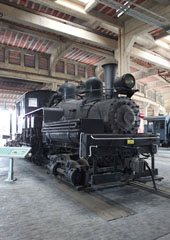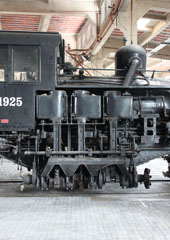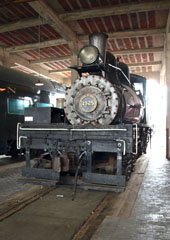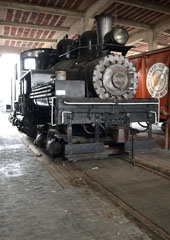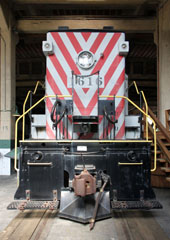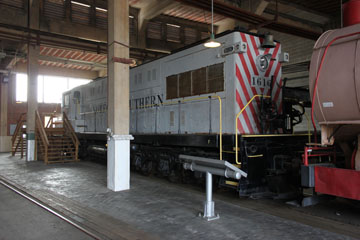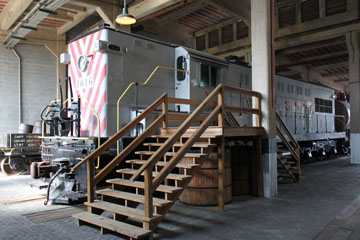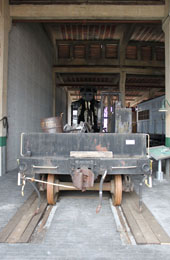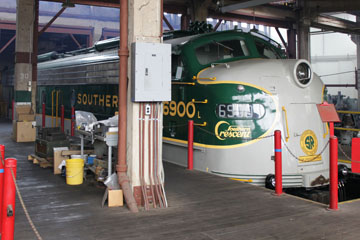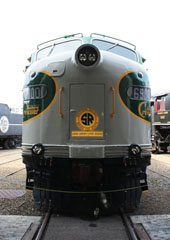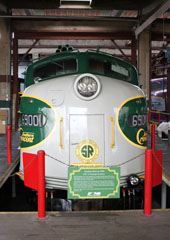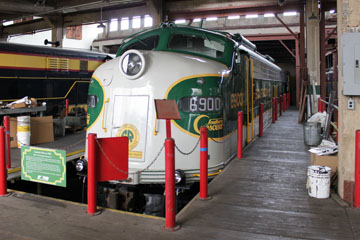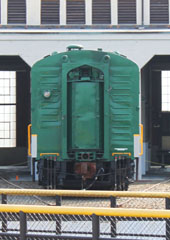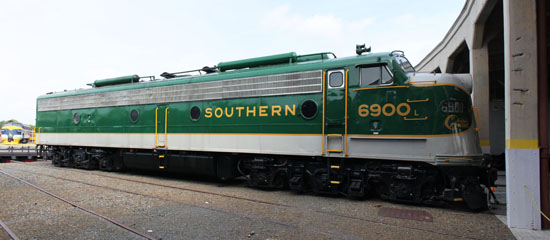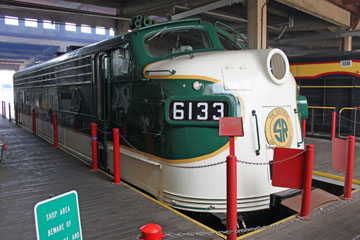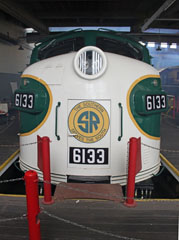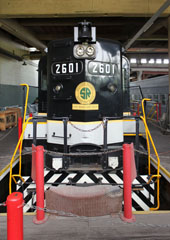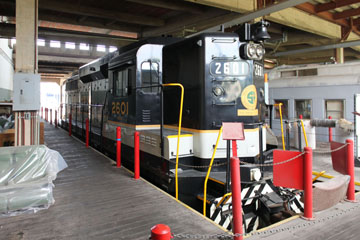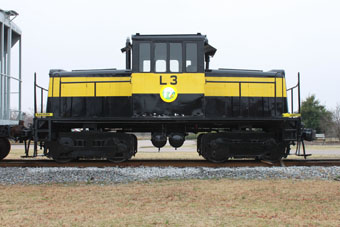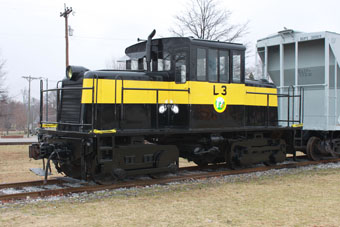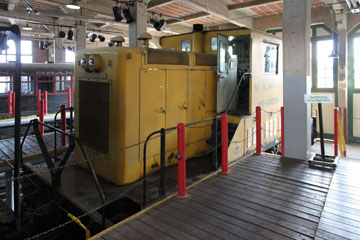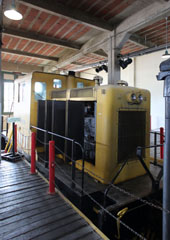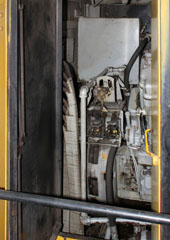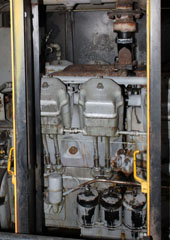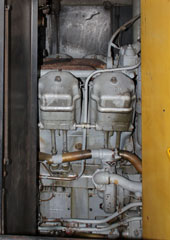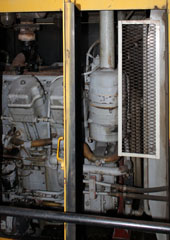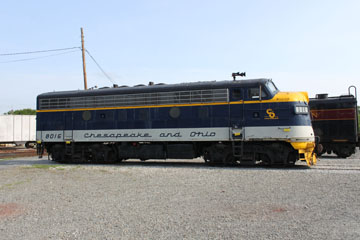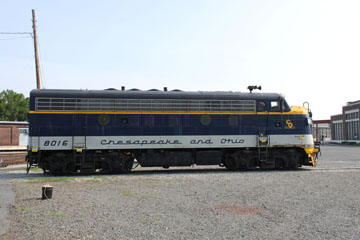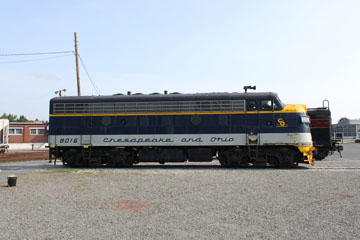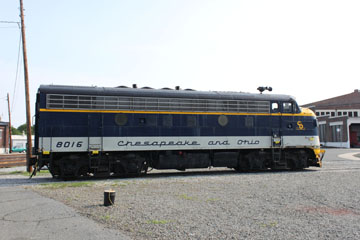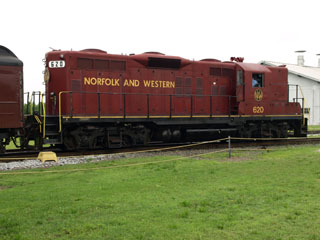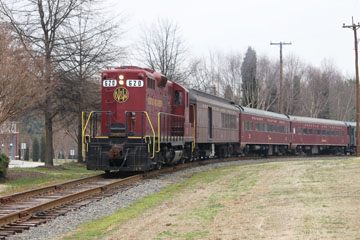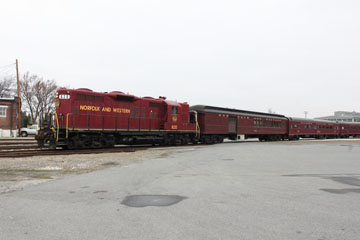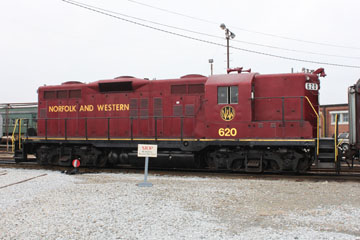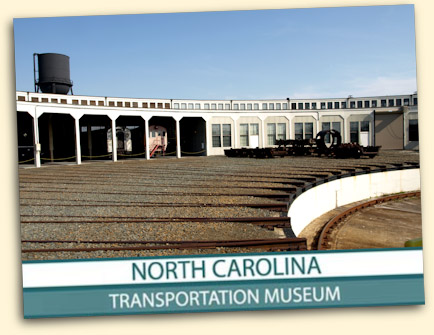

The North Carolina Transportation Museum is located
on the site of what was once Southern Railway's
Spencer Shops on South Salisbury Avenue in Spencer, NC, about two miles off the I-85. The first exhibit area opened in 1983, and the many acquisition, restoration
and improvement efforts carried out by staff and volunteers over the ensuing years have combined to create a truly excellent collection. Not all buildings on the site are open to the public, however, as restoration efforts continue.
The museum is largely devoted to North Carolina's railroad history. Although the collection also includes exhibits of automobiles and aircraft, it holds almost thirty locomotives. Most are from railroads historically operating in America's southern states, but only about a third have any direct historical connection with the Spencer Shops.
The museum also has a heritage railroad, which runs passenger excursion trains several times a day during the tourist season. Trains are powered either by steam or diesel locomotives from the collection.

The Spencer Shops were the largest locomotive shop on Southern's system and were located roughly at the half way point on the railroad's line between Atlanta, GA and Washington, DC. They were named after Southern Railway's then President, Samuel Spencer.
Building started on 23rd March 1896 and the Shops opened on 19th August 1896, with Samuel Spencer presiding. They employed thousands of workers, many of whom settled in the new town of Spencer formed from lots adjacent to the Shops and sold by Southern. At the height of operations in WWII, about three thousand staff worked in the Shops, which provided most of the employment in Spencer and the surrounding areas.
 |

Historic Marker |
 Water Tanks |
 Sandblasting Tower |
 Mule Winch |
 Barber Junction Depot |
 Paint Shop |
 Power House |
 Back Shop |
 Master Mechanic's Office |
 Storehouse No.3 |
 Flue Shop |
 Lye Pit |
 Car Repair Shed |
 Robert Julian Roundhouse |
 100' Turntable |
 Oil Shop |
 Radio Shop |
 Ice House |
 Roundhouse Office |
 Fuelling Tracks |
 Water Stand Pipe and Ash Pit |
 Wheel Balancing Shed |
 Sand House |
 Water Tank |
 47 Track Yard |



As Southern dieselised in the 1940s and 1950s, the Spencer Shops were progressively run down. The repair facility closed in 1960, but the classification yard stayed open until Southern moved to a new yard at Linwood, NC, in 1979.
Southern donated the site to the state of North Carolina in two stages. The first four acres with three buildings, were gifted in 1977 when the North Carolina Transportation History Foundation was established. It is formed of local business leaders, former railroad employees and local politicians, and assists with fund-raising, educational programmes, grant writing and soliciting donations. Southern gifted a second part of the site in 1979, which included a number of other historic buildings and, eventually, the entire site came under the administration of the North Carolina Department of Cultural Resources.
 Left, the historic maker on South Salisbury Ave just outside the museum.
Left, the historic maker on South Salisbury Ave just outside the museum.
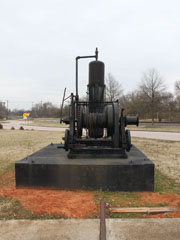
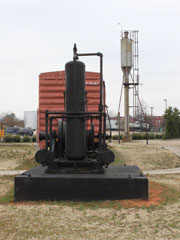
 The Mule Winch above and right pulled equipment through the sandblasting area. All equipment destined for the Paint Shop was first sandblasted here in preparation for painting.
The Mule Winch above and right pulled equipment through the sandblasting area. All equipment destined for the Paint Shop was first sandblasted here in preparation for painting.
In the background, SOU Boxcar #262914 was built by Pullman Standard in the 1950s.
It carried bulk commodities in dry, clean conditions.
 Below, Barber Junction Depot. This is the main Visitor Center and departure point for train rides at the museum. The depot was built by Southern in 1898 and moved to the museum in 1980 from the nearby town of Barber, NC.
Below, Barber Junction Depot. This is the main Visitor Center and departure point for train rides at the museum. The depot was built by Southern in 1898 and moved to the museum in 1980 from the nearby town of Barber, NC.
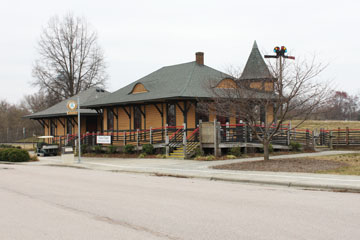
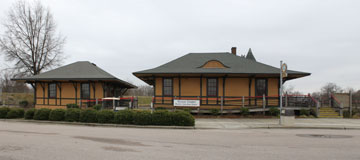



 Above, two views of the Paint Shop. Built in 1902, this was originally a tender repair facility. It became a paint shop in 1950, when overhead fans were installed for ventilation.
Above, two views of the Paint Shop. Built in 1902, this was originally a tender repair facility. It became a paint shop in 1950, when overhead fans were installed for ventilation.
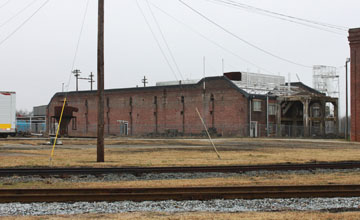
 Above, the Power House, built in 1913.
Above, the Power House, built in 1913.

Above,  the Power House (left),
the Power House (left),  the Back Shop (centre) and
the Back Shop (centre) and  the Master Mechanics Office (right).
the Master Mechanics Office (right).
In this view, Buffalo Creek & Gauley #4 is on display with SOU Baggage Car #6262. Originally built as a Sleeping Car for the Crescent Limited in 1926, #6262 was rebuilt in 1954 as a Baggage Car. It was donated to the museum by the Winston-Salem Chapter of the NRHS.

 Above, the Back Shop. It was built in 1905 and is 64' high, 596' long and 150' wide. This was once the largest industrial building in North Carolina.
Above, the Back Shop. It was built in 1905 and is 64' high, 596' long and 150' wide. This was once the largest industrial building in North Carolina.
The Back Shop served as an enormous machine shop for the entire facility. Here, workers stripped and rebuilt locomotives on a production line with the aid of an overhead crane.
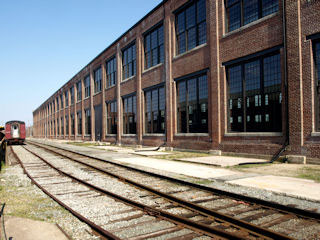
When it was operational, the Back Shop could accommodate fifteen locomotives at a time and, at its operating peak, two or three locomotives were outshopped after undergoing repairs each week.
When I last visited, the building was undergoing renovation. However, it has since reopened and houses some of the museum's larger items.
 Below, the Master Mechanics Office built in 1911. The Master Mechanic, Payroll, Clerk and Danville Division officials occupied the north end of the building.
Below, the Master Mechanics Office built in 1911. The Master Mechanic, Payroll, Clerk and Danville Division officials occupied the north end of the building.

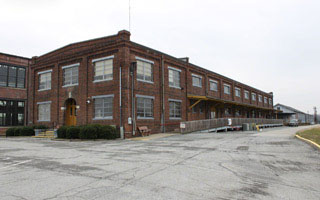
Below, the south end was used as a warehouse for tools and other supplies.
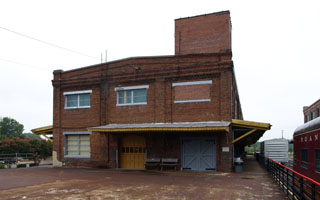
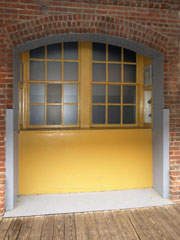

Above, two views of the restored issue window at the Master Mechanics Office. Employees would draw equipment here from the warehouse at the southern end of the building.
The Master Mechanics building now houses the museum gift shop and the "Wagons, Wheels, and Wings" exhibition.
 Below, the north end of Storehouse No.3. It is the oldest building on the site.
Below, the north end of Storehouse No.3. It is the oldest building on the site.
Built in 1896, it was first used as the Master Mechanics Office. After 1911, it was used as a storehouse for general parts and, in 1916-17, it was moved to its current location.
Note the spur line on the right. This permitted freight cars to be loaded and unloaded at the storehouse.
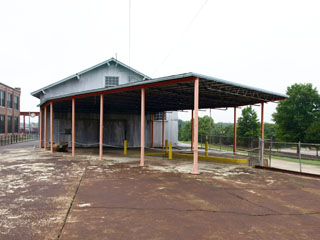
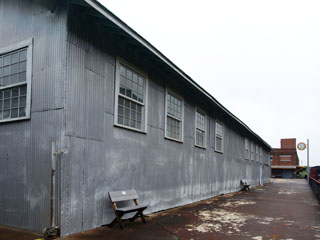
Above, a view of the south end of
Storehouse No.3. The building is not open to the public.
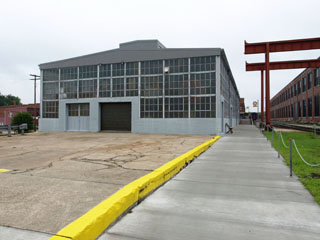
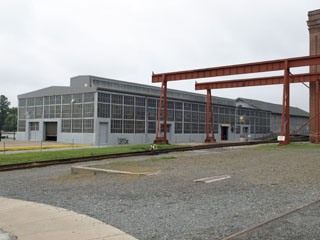
 Above, two views of the south end of the Flue Shop built in 1924. Here, boiler flues from steam locomotives were reconditioned and repaired. One end of the Lye Pit gantry, also built in 1924, can be seen on the right in both these views.
Above, two views of the south end of the Flue Shop built in 1924. Here, boiler flues from steam locomotives were reconditioned and repaired. One end of the Lye Pit gantry, also built in 1924, can be seen on the right in both these views.
The Flue Shop houses the "Bumper to Bumper" exhibition, which traces the evolution of the automobile in North Carolina from small buggies through 1940s roadsters to modern cars. The collection ranges from a 1901 White Steam Stanhope to a 1978 Plymouth North Carolina Highway Patrol car.


The gantry was built to carry locomotives and other equipment to the Lye Pit for cleaning. The Lye Pit is at the end of the gantry in the view below.
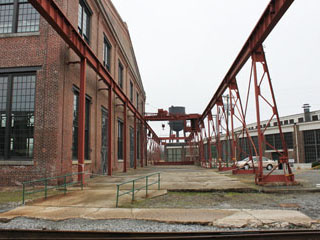

 Above, the location of the old Lye Pit. Here, equipment was dipped in a caustic lye solution to remove grease and accumulated dirt. The pit was filled in some time ago.
Above, the location of the old Lye Pit. Here, equipment was dipped in a caustic lye solution to remove grease and accumulated dirt. The pit was filled in some time ago.
 The Car Repair Shed, built in 1917, can be seen in the rear left of the view above. Passenger and freight cars were repaired and rebuilt in this building.
The Car Repair Shed, built in 1917, can be seen in the rear left of the view above. Passenger and freight cars were repaired and rebuilt in this building.
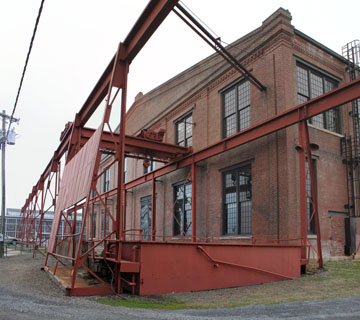
Above, another view of the Lye Pit gantry.
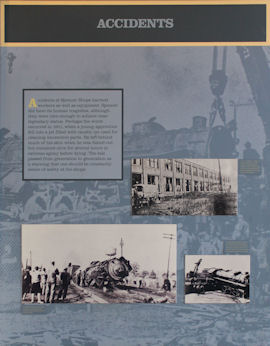
Accidents were inevitable in a large yard like Spencer. Perhaps one of the most gruesome is recorded in the museum display panel above. The description reads:
Accidents at Spencer Shops harmed workers as well as equipment. Spencer did have its human
tragedies, although they were rare enough to achieve near legendary status. Perhaps the worst occurred in 1911, when a young apprentice fell into a pit filled with caustic lye used for cleaning locomotive parts. He left behind much of his skin when he was fished out but remained alive for several hours in extreme agony
before dying. The tale passed from generation to generation as a
warning that one should be
constantly aware of safety at the shops.

 Above, a panorama of the thirty-seven stall roundhouse completed in 1924. Named after foreman Robert Julian, it was one of the largest roundhouses ever built in the US.
Above, a panorama of the thirty-seven stall roundhouse completed in 1924. Named after foreman Robert Julian, it was one of the largest roundhouses ever built in the US.
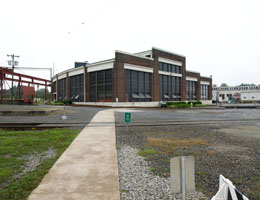
The renovated roundhouse was rededicated in 1996, on the centenary of the original opening of the Spencer yard. It is one of the few original roundhouses still in existence in the US today and probably the largest.
As well as housing the museum's locomotive collection during winter, the roundhouse has exhibits focusing on the lives of the men
and women who made Spencer Shops run. There are video presentations, interactive exhibits and a scale model of Spencer
Shops, as well as an operational work shop with an observation area to view cars and locomotives being restored.
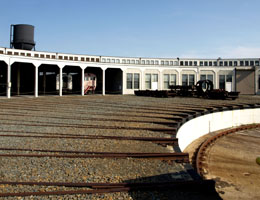
The roundhouse was used to
service as well as store motive power. While it was in full operation, seventy-five to eighty locomotives passed through every day. There were drop pits to inspect running gear, axles and journals. and one of the service points for the Ps-4 Pacifics (you can see Ps-4 #1401 on the Smithsonian Museum page of this website).
Today, the western part of the roundhouse houses the museum's active motive power: SOU EMD E8 #6900, SOU EMD FP7 #6133, SOU EMD GP30 #2601, Beaufort & Moorehead Fairbanks-Morse
H-12-44 #1860 and NW EMD GP9 #620.
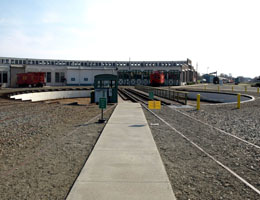
 Above, the 100' diameter, electrically operated turntable. The museum conducts five minute rides every half hour between 10.00am and 4.00pm. The rides are narrated by a museum guide.
Above, the 100' diameter, electrically operated turntable. The museum conducts five minute rides every half hour between 10.00am and 4.00pm. The rides are narrated by a museum guide.
A turntable is also used to turn railroad rolling stock. This was
more important while steam locomotives were still in wide use,
as most were not designed to operate in reverse for long runs and, for many locomotives, their top speed was lower running in reverse. With the advent of diesels, which could easily operate in both directions, however, turntables became a less important part of the railroad yard.
 Below, the Oil House built in 1913.
Below, the Oil House built in 1913.
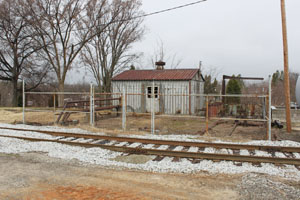

Oil tanks adjacent to the Oil House. A locomotive service area is to the rear.
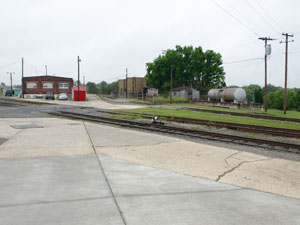
Above, the Ice House (left), service area (centre) and Oil House (right).
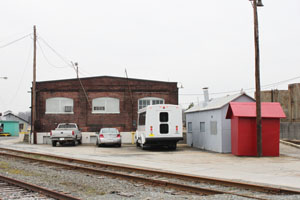

 Above, the Ice House. This once held ice used to pack refrigerator cars before perishable goods were loaded and transported.
Above, the Ice House. This once held ice used to pack refrigerator cars before perishable goods were loaded and transported.
Refrigerator cars often underwent several hours of "pre-cooling" prior to loading, which saved ice. This involved blowing cold air through one ice hatch and venting the displaced warmer air through the other hatches. The cars' ice bunkers were then filled.
In the latter half of the 20th Century, mechanical refrigeration began to replace ice-based systems and the personnel required to re-ice the cars.
The building is now used for museum offices.
 Below, the old Roundhouse Office
Below, the old Roundhouse Office
built in the 1930s. Operation of the
existing roundhouse and a second turntable and stalls (visible in the aerial photograph of the Shops) were conducted here.
The building is now the Yard Office.
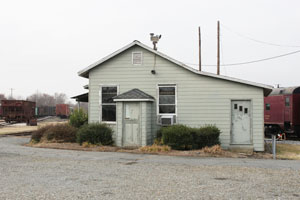
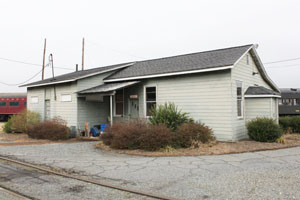
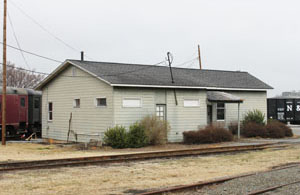
 Below, the Ash Pit is adjacent to the Water Standpipe.
Below, the Ash Pit is adjacent to the Water Standpipe.
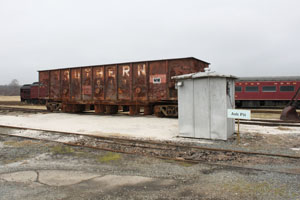
To remain fully serviceable, steam locomotives must be regularly cleaned. Ash and cinders must be removed from the firebox or they will clog the grate and reduce firing. If ash pans are not emptied, ash will accumulate and hot coals will
build up, potentially
setting fire to the grate.
This ash pit was dug for the museum's steam operations. It is used both for dropping fires when a locomotive is to go into storage and for building fires when they are fired up again.
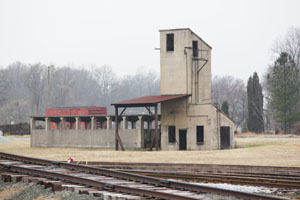
 Above, remains of the Sand House. It was built in 1913.
Above, remains of the Sand House. It was built in 1913.

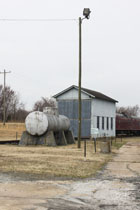
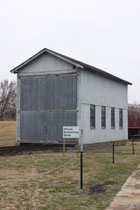
 Above, the Wheel Balancing Shed.
Above, the Wheel Balancing Shed.
This houses scales that were used to balance wheel axles on steam
locomotives.
It was built during the 1940s and remained in use until steam was fully retired from the Southern system in 1953. However, the museum has subsequently used the scales to balance wheels on its own motive power.
Properly balancing locomotive wheels is an important part of their servicing routine. Improperly balanced wheels will impair a locomotive's pulling power, twist axles, cause side-to-side rocking, loosen frame bolts and cause "pounding", which will roughen the ride and damage rails.

Last time I was at the museum, NW #611, a Northern (4-8-4) type locomotive, was standing cold in the yard after a weekend excursion from Lynchburg to Petersburg, VA.
#611 is one of fourteen Class J passenger locomotives built by the Norfolk & Western Railway between 1941 and 1950 and the only one still in existence today. It is owned by the Virginia Museum of Transportation, and you can see more photos and find out more about the engine on the Virginia Museum of Transportation page of this website.
On 21st May 2015, #611 made a brief test run from Spencer to Greensboro, NC, pulling the museum's "Powhatan Arrow" passenger cars. On 30th May, it hauled its first excursion from Spencer, NC, to Roanoke, VA.
Future excursions are planned in conjunction with Norfolk Southern as part of that company's “21st Century Steam” program.
In 2013, the "Fire Up 611" committee established by the Virginia Museum of Transportation announced that #611 was to be restored to operating condition. It was moved to the North Carolina Transportation Museum roundhouse in Spencer, NC, in late May 2014, where restoration work began the following month.
Restoration was carried out with the help of volunteers, including several from the Age of Steam Roundhouse in Sugar Creek, OH. On 31st March 2015, #611 was fired up for the first time in over twenty years for a test fire,and, on 9th May, it ran under its own power as part of the first round of post-restoration testing.




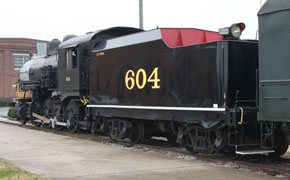
This Consolidation type (2-8-0) locomotive was built for the National Railway of Mexico as oil burner #200 by Baldwin in 1926, but was never delivered. Instead, it was converted to burn coal and sold to the Buffalo Creek & Gauley Railroad in West Virginia as #4. It weighs 191,700 lbs and has 51" drivers and 22" x 28" cylinders.
The Buffalo Creek & Gauley was chartered in 1904 and ran 18.6 miles along Buffalo Creek between Dundon and the Rich Run Mine at Widen, WV. Primarily a coal hauling line, it never operated a diesel and, in 1960, it had become the largest all-steam railroad in the US. On 30th December 1963, the last coal train left Widen and the Rich Run Mine was finally closed. The last steam train ran from Swandale to Dundon on 27th February 1965.
There was a rail fan trip on the Buffalo Creek & Gauley in Summer 1963 and, during its final years, as many as 20,000 rail fans came to view the railroad's steam operations.
In 1964, #4 was sold to the Quakertown & Eastern, a tourist line operating out of Quakertown, PA. It was then purchased by the Southwest Virginia Scenic Railroad in Hiltons, VA.
The museum bought #4 in 1978. Restored to operating condition in 1987, it hauled museum train rides lettered as Southern #604. On 4th November 1995, the museum hosted a commemoration of the 30th anniversary of #4's final run from Swandale, for which it was restored to its Buffalo Creek & Gauley livery. It has since been sold to the Durban & Greenbrier Valley Railroad for restoration to work on the restored C&O Cass-Durbin, WV, line.
Operating at a boiler pressure of 180 psi, it delivered 41,500 lbs tractive effort.

Consolidation type
(2-8-0) locomotive #542 was built for the Southern in 1903 by Baldwin and is the only survivor of ninety of this J class rostered by the railroad.
It served mainly in freight service around Statesville and Winston-Salem, NC.
The engine has been restored to look as it did working on the Atlantic & Yadkin Railroad in 1947. It has a 16' driver wheelbase and engine wheelbase of 24' 4". It weighs 171,550 lbs,152,225 lbs on its 56" drivers. With Stephenson valve gear and 21" x 28" cylinders, total heating surface is 2,761 sq ft. The grate is 44 sq ft and the firebox 182.5 sq ft. A coal burner, it operated at a boiler pressure of 200 psi delivering 37,485 lbs tractive effort.
The tender weighs 120,000 lbs light and has a 6,000 gallon water and 12 ton coal capacity.
The Atlantic & Yadkin Railway was a short line wholly owned by the Southern Railway operating between 1899 and 1950 from Mount Airy southeast to Sanford, NC. #542 was rented to the A&Y by the Southern at various times between 1937 and 1946.
In 1954, after retirement, #542 was donated to Tanglewood Park, near Clemmons, NC. In 1991, the museum traded ex-Illinois Central 0-8-0 #1894 for the locomotive. #542 was cosmetically restored as Southern #604 and used in the 2008 Leatherheads movie, starring Renée Zellweger and George Clooney.

#3 is a "fireless" or "steam storage" locomotive built by the H. K. Porter Locomotive Company in 1937. With an insulated tank instead of a firebox and boiler, it could be charged from a stationary boiler in about 15 minutes and would run 2-5 hours, depending on working conditions. These locomotives were used in locations where a large, ready supply of steam was available or where locomotive cinders would be dangerous.
#3 weighs 140,000 lbs with 18½" x 16" cylinders and 44" drivers. Operating at 150 psi full pressure, it delivered 23,000 lbs tractive effort.
The locomotive was delivered to the Carolina Power & Light's Lumberton Plant in NC in 1949.
#3 continued in service at the Lumberton plant until 1980, when it was donated to the State of North Carolina and moved for display at the museum.

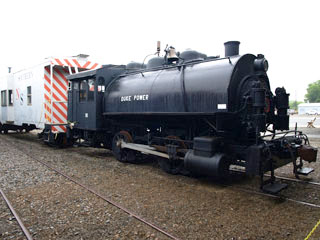
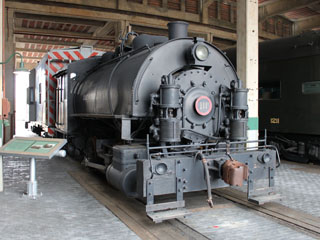
Alco built this 0-4-0T (Tank) in about 1922 and sold it to the Stewart-Jones Company of Great Falls, SC, in February 1922. In July 1924, it was sold to the Wateree Power Company, which later became part of the Duke Power Company.
Duke Power used #111 at their Mt. Holly and Cliffside plants in North Carolina, as well as at the Buck Steam Plant on the Yadkin River north of Spencer, NC. Otherwise, not much is known of its service history before 1942 or after 1953.
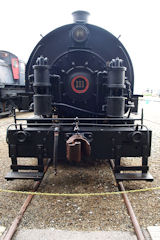

#111 weighs 79,000 lbs and has 38" drivers and 13" x 20" cylinders. It operated at a boiler pressure of 200 psi, developing 15,121 lbs tractive effort.
The locomotive was donated to the State of North Carolina in the late 1970s.
#111 is typical of thousands of industrial switchers produced by US manufacturers in the early 20th Century.

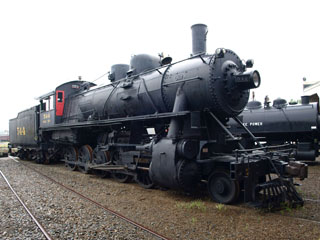
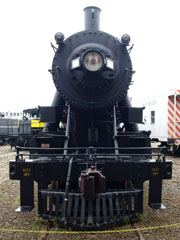
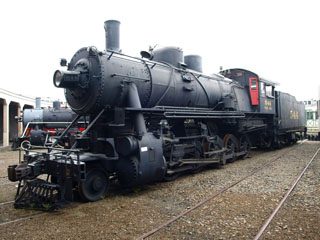
Twelve hundred of this Decapod (2-10-0) type were ordered from Baldwin and Alco for export to Russia. Eight hundred and fifty-seven were delivered but, when the Russian government was overthrown by the 1917 Revolution, about two hundred were diverted to US railroads by the USRA.
Built for Russia's 5' gauge, they were not regauged for the US
4' 8½" gauge. Although the front pilot was replaced, the drivers were simply fitted with wider tyres.
When built for the Russian Railway by Alco in 1918, #544 was numbered #E1198. It was assigned by the USRA to the Wheeling & Lake Eire Railroad as #1088 and then sold to the Detroit, Toledo & Ironton in 1926, where it became #311.
The Seaboard acquired the locomotive in 1935 and renumbered it #544. The railroad eventually rostered thirty-eight of this type of locomotive.
Weighing 210,000 lbs, it has 25" x 28" cylinders and 52" drivers. With a 65 sq ft grate, 227 sq ft firebox, total heating surface of 3,189 sq ft, including 579 sq ft superheating, it operated at a boiler pressure of 180 psi delivering 51,490 lbs tractive effort.
Known as "Russians" by their crews, they served on branch lines throughout the Seaboard system, mainly out of Hamlet and Raleigh, NC. During the 1950s, they were transferred to the Gainesville Midland, a Seaboard subsidiary in Georgia. You can see two non "Russian" GM Decapods on the GM #208 and GM #209 pages of this website.
#544 went on display in Atlanta, GA, in 1965 and was sold to the North Carolina Railroad Company in 1980, which then donated it to the State of North Carolina.
You can see other "orphaned" Decapods on the Museum of the American Railroad page of this website, the National Museum of Transportation, St. Louis Yard page and the Illinois Railway Museum Yard page.

#1031 is one of twenty-five Ten Wheeler type (4-6-0) locomotives built
for the Atlantic Coast Line by Baldwin in 1913. It has 64" drivers and
20" x 26" cylinders. With a 44.1 sq ft grate, 181 sq ft firebox and total heating surface of 2,449 sq ft, including 400 sq ft superheating, it operated at 200psi delivering 27,600 lbs tractive effort.
The locomotives quickly earned the nickname "Copperheads", because they originally had polished copper rims around the tops of their smokestacks. Primarily used to haul both freight and passenger services in the Fayetteville, Rocky Mount and Wilmington, NC, district they nevertheless worked as far afield as Richmond, VA, and Jacksonville, FL. As dieselisation gathered pace on the ACL, many were transferred to serve on smaller subsidiary lines.
For most of its life, #1031 operated mainly out of Florence, SC, hauling freight and passenger trains. It was taken out of service in 1952, but was then lent to the Atlantic Coast Line subsidiary, the Virginia & Carolina Southern. Later it was transferred to the East Carolina Railway.
In 1959, it was placed on open air display behind the Florence, SC, passenger station but, after continuing deterioration in its condition, the City of Florence donated it to the museum in 1994. Two years later, it was cosmetically restored to its 1940s appearance.

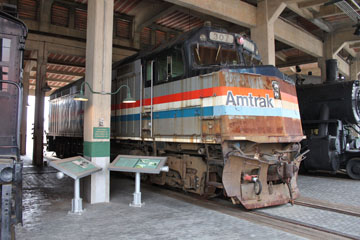
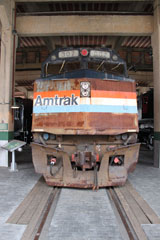
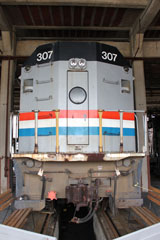
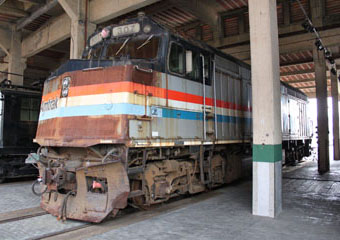
#307 was built by the EMD in 1979. Two hundred of these F40PH units were produced between 1976 and 1991.
With its chopped nose, the unit became the signature face of Amtrak trains for twenty-five
years, although the model was also purchased by other carriers. From the 1990s, however, they were progressively replaced by GE P42 units. By 2000, most had been replaced in service, although
several were converted into baggage cars by removing their diesel engines and installing roll-up side doors.


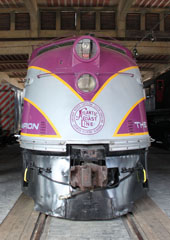
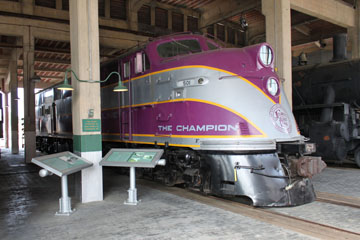
#501 was one of two diesel-electric units bought by the Atlantic Coast Line for its prestigious New York, NY, to Miami, FL, train, The Champion, in 1939 (#500 & #501).
Built by the Electro-Motive Corporation of La Grange, IL, (later EMD) #501 is an E series unit, one of the company's first high production models. Each locomotive produced 2,000 hp from two 1,000 hp 12 cylinder 567A prime movers each powering a GM D4 generator to drive four GM D7 traction motors. The E3s could reach a top speed of 116 mph.
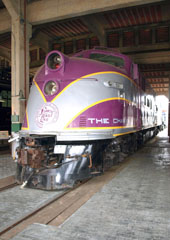
Sixteen E3A units were built and two cabless B units from 1939 to 1940. Both units were 71' 1" long. The A unit weighed 315,000 lbs, the B unit 290,000 lbs.
The Champion began as a daily service in 1939, competing with the Seaboard Air Lines Silver Star and Silver Meteor services. In 1941, the ACL added a St. Petersburg train called the Tamiami Champion (West Coast), at which time the Miami train became the Tamiami Champion (East Coast). In 1943, the names were simplified to the East Coast Champion and West Coast Champion.
After the merger of the ACL and SAL into the Seaboard Coast Line in 1967, The Champion remained as a New York–St. Petersburg service. Following formation of Amtrak in 1971, The Champion was finally discontinued in 1979.
After retiring, #501 was bought by the Colorado entrepreneur for a private ski train in 1972. In 1977, it was sold to Glen Monhart to run excursions in Wisconsin. The North Carolina Department of Transport Rail Division eventually bought #501 in 1999 to loan to the museum. It is still operational.

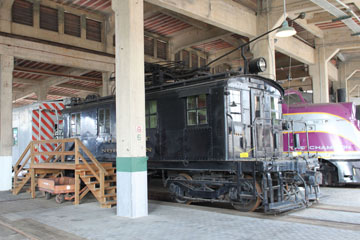
Above, Piedmont & Northern Railway electric locomotive #5103. It was built by General Electric in 1913. Power was fed either through a 600 volt DC trolley pole or a 1,500 volt DC overhead catenary to four 250 hp engines, and the locomotive could haul up to thirty freight cars.
The Piedmont & Northern was created in 1914 to consolidate the electrified Greenville, Spartanburg & Anderson Railroad in South Carolina and the Piedmont Traction Company in North Carolina, both owned by James B. Duke of Duke Power. The Piedmont & Northern was the only mainline Class I railroad in the south to use electric locomotives, and was the first electric railroad in the US to operate both passenger and heavy freight electric services.
The railroad also had a divided right-of-way, with part operating Charlotte to Belmont, NC, and the other Spartanburg to Greenwood, SC. The company sought to link the two disconnected segments and expand to Durham, NC, a number of times, but the efforts never paid off because of stiff resistance from the Southern Railway, which had parallel track in both states. The Seaboard Coast Line bought the Piedmont & Northern in 1969.
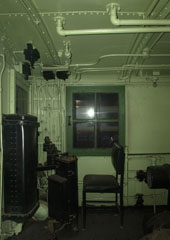
#5103 started work on the Spartanburg-Greenwood division of the Piedmont & Northern, but moved to the Charlotte-Belmont division in 1950 when the South Carolina division converted to diesel. Electric power ended on the North Carolina section in 1954. Some of the railroad's electric locomotives were then shipped to South America and, except for #5103, the rest were scrapped.
#5103 ended its life operating on old trolley tracks on Mint Street in downtown Charlotte, NC, in 1958. It was donated to the Atlanta, NRHS Chapter in 1963.

In the pre-civil rights years, African-Americans on
trains like The Champion had to travel in "colored" or "Jim Crow" coaches in the South, although whites could, and sometimes did, also travel in these cars. There were also segregated cars on some railroads in the North, the coaches
often being combined baggage/passenger carriages that were hauled directly behind the locomotive.
African-Americans also had to eat at designated tables in curtained off areas next to kitchens in the dining cars, and could not enter observation or lounge cars at the rear of trains.
SOU Coach #1211 was built in about 1922. It had twenty-two seats in the white area and twenty-two in the "colored" part. The rest rooms for African-American passengers were much smaller, had less light and no foyers.
By 1964, coaches like this were no longer used by the Southern and #1211 was retired in 1969.
In 1980, it was bought from the Atlanta NRHS chapter by the North Carolina Railroad for the museum.

The Spencer Shops employed a large number of African-American workers. The panel above, on exhibit at the museum, describes their life in their own words.

Nevertheless, African-American workers at the Spencer shops faced discrimination and segregation.
They typically held labouring jobs, with little prospect of advancement.
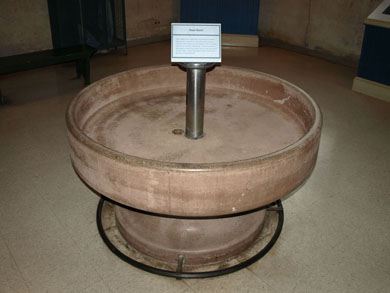
There were separate washrooms for white and "colored" workers at the facility. The white washrooms were in the roundhouse, while the "colored" washrooms were in the Back Shop.
Wash rooms were equipped with basins like the one in the photo above. The foot pedal controlled the flow of water to the sprinkler at the centre. Soap dispensers were placed at the top of each sprinkler.
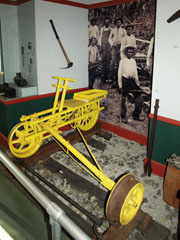
Gangs of African-American "gandy dancers", like the one shown in the background of the view above, carried out much of the heavy labour on early Southern railroads. They most often worked under white foremen.
Crews used the hand powered yellow velocipede shown above to travel between jobs, inspect the right of way and spot defects.
Work gangs used the equipment displayed here to grade and lay track, and replace worn rails and sleepers. It was hard work, sometimes leased to local prisons using convict labour in the late 19th and early 20th Centuries.


Built by Lima in 1925, #1925 this three truck Shay was numbered by the Graham County Railroad for the year in which it was built. It weighs 142,000 lbs and has 36" drivers and three 12" x 15" vertically mounted cylinders. A coal burner operating at a boiler pressure of 190 psi, it delivered 30,350 lbs tractive effort.
#1925 hauled lumber out of the Snowbird Mountains to the Bemis Lumber Company mill in Robbinsville, NC. The logging portion of the railroad closed in 1948, but the remainder carried general freight between Robbinsville and Topton, NC, to an interchange with the Southern Railway. Because of falling demand and deteriorating track conditions, however, the Graham County ceased operations in 1970. Until then, it had been the last commercially operating steam freight line in the US. In 1974, a tourist operation, the Bear Creek Scenic Railroad, tried to re-open the line to Robbinsville, but this also ceased operation within a few years.
#1925 was donated to the museum in 1988, and restored to operation in 1998 to pull on-site train rides. It has also hauled excursions on the Smoky Mountain Railroad out of Bryson City, NC.

#1616 is an AS-416 switcher. Amongst the last locomotives designed by Baldwin, twenty five of which were built from 1950 to 1955. Seventeen were bought by this particular company named Norfolk Southern, although this is not the Norfolk Southern conglomerate formed in 1982, but a small, largely coastal line that operated in Virginia and North Carolina.
#1616 weighs 245,800 lbs. It has a 1,600 hp 608A prime mover powering a WE471 generator to drive four WE370 traction motors with a top speed of 65mph.

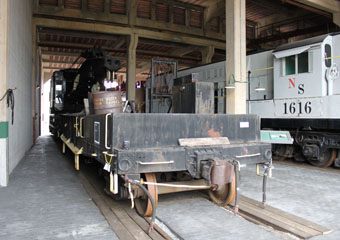
#903006 is a 150 ton railway derrick built by the Bucyrus Company of Milwaukee, WI, in 1921 for Southern.
#903006 was steam-powered until 1971, when Southern converted it to diesel and assigned it to work out of New Orleans, LA.
Originally numbered D-66, the derrick has four outriggers that can be extended to increase its stability. With booms extended to a 17' radius, it could lift 300,000 lbs. These cranes were used at train wrecks and derailments to lift locomotives and carriages back onto the rails, and the Southern kept several of them strategically located across its system.
Norfolk Southern, successor to the Southern, retired #903006 in 1989 and donated it to the museum in 1990. It is displayed with SOU Boom Car #910016.

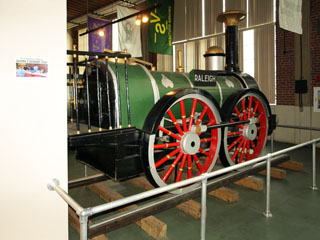


The "Raleigh" is a replica of the first steam locomotive to operate in North Carolina. It is on display in the indoor exhibition area.
The original "Raleigh" was built by C. Tayleur & Company, an affiliate of Robert Stephenson & Company in England in 1836. It was one of two 0-4-0 locomotives built for the Raleigh & Gaston Railroad and shipped to the US. Along with the second locomotive, the "Gaston", it was used to begin construction of the first sections of the Raleigh & Gaston.
Construction of the Raleigh & Gaston was completed in April of 1840 at a total cost of $1,343,380.00 including locomotives and cars. Laying of the eighty-six miles of wood and iron strap track was largely the work of leased slaves. It was North Carolina's second railroad, the Wilmington & Raleigh Railroad having beaten it to the title by just one month.
In 1900, the Raleigh & Gaston merged with the Seaboard Air Line and the tracks eventually became part of the CSX System.
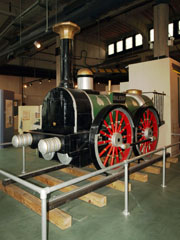
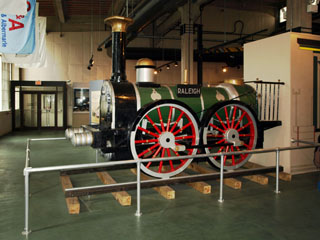

The replica "Raleigh" was built in 1927 by the Seaboard Air Line shops in Raleigh, NC. It was donated to the museum by the Seaboard in 1965.
The original "Raleigh" saw three decades of service, including working for both the Confederate and Union forces during the American Civil War.


The panorama above takes in part of the museum's work shop next to the indoor exhibition area. On the left, W. R. Bonsal
0-6-0T (Tank) #7 is undergoing an
overhaul.
Built by the H. K. Porter Locomotive Company in 1942 for the US Army as
#5012, this switcher was moved to Charleston, SC, in 1946. The following year, it was bought by the W. R. Bonsal Company, a gravel operation in Lilesville, NC. The Bonsal Company donated it to the museum in 1979.
#7 is a coal burner weighing 100,650 lbs with 47" drivers and 16½" x 24" cylinders. It operated at a boiler pressure of 190 psi delivering 21,630 lbs tractive effort.
H. K. Porter started operations in 1866 in Pittsburgh, PA, manufacturing light-duty locomotives, and became the largest producer of industrial locomotives in the US, building almost eight thousand of them. The last locomotive was outshopped in 1950 for a railroad in Brazil. H. K. Porter also built Carolina Light & Power #3, shown earlier on this page.
On the right in the view above, you can see the tender of Southern J class Consolidation type (2-8-0) locomotive #542, which was in the shop undergoing restoration when I took this photo. You can see photos of it restored as Atlantic & Yadkin #542 earlier on this page.
The mission of the North Carolina Transportation Museum and Foundation is to preserve and interpret the history of transportation in North Carolina and to present this history in a manner that allows visitors to enjoy their experience as well as learn from it. Objectives related to the mission are:
• To preserve the buildings and other historic features of Spencer Shops.
• To interpret the history of the Southern Railway repair facility, the community and the people who were associated with it.
• To operate an on-going program of transportation artifact restoration and conservation.
As part of meeting the last objective, the shops rebuilt NW J Class #611.

This was the first of seven E8 units ordered by the Southern from EMD in 1951.
Four hundred and forty-nine E8As and forty-six E8Bs were built between 1949 and 1953. The snub nose of the cab units earned them the nickname "bulldog nose".
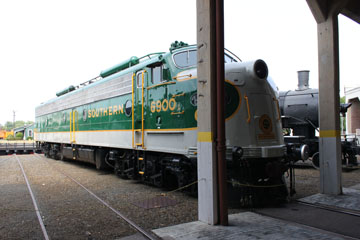
Weighing 315,000 lbs (290,000 lbs for the B units) and 70' 3" in length, the E8 is equipped with two 12 cylinder GM 567B prime movers powering two GM D27 generators to drive four GM D37 traction motors, one on each axle. With a top speed of 85 mph it develops starting tractive effort of 56,500 lbs at 25% and continuous tractive effort of 31,000 lbs at 11 mph.
Until Amtrak took over passenger services in 1971, the seven E8s hauled Southern's crack passenger trains, including the Royal Palm, the Southern Crescent, Southerner and Tennesseean. They were initially painted green with aluminium striping but changed to black in the late 1950s. In 1972, Southern President W. Graham Claytor had all the E8s returned to green and aluminium to reflect pride in the railroad's history. At the same time, #2923 was renumbered #6900. It ended its career hauling the Southern Crescent in 1979, and was donated to the museum in 1980.
You can see SOU E8 #6901 on the Southeastern Railway Museum page of this website and other E8s on the St Louis Museum Transportation Sheds, Gold Coast Railroad Museum and the National New York Central Museum pages.

Built by EMD in 1950, #6133 is one of twenty FP7s rostered by the Southern (#6130-#6149)
Three hundred and twenty-four FP7 units were built for US railroads between 1949 and 1953, along with fifty-nine FP7B units. A further fifty-seven FP7 and twenty-nine FP7B units were built for Canadian railroads by EMD's subsidiary, GMD in London, Ontario.
The FP7 has a 16 cylinder 567B prime mover powering a GM D12D generator to drive four GM D27 traction motors. Incorporating water tanks and steam generators, they were designed to haul passenger trains, but also hauled freight.

Southern's FP7s were used on small branch-line passenger trains throughout the system. By the late 1970s, however, very few remained on the roster as Southern had eliminated many of its passenger trains. Those that were left were sometimes used on excursion trains as part of Southern's Steam Program begun in 1966. #6133 was donated to the museum in 1980 and restored to its original green and aluminium paint scheme. It is sometimes used to haul on-site train rides.
The haze in the background of these photos is caused by NW #620 having just left the
roundhouse in readiness to haul a museum passenger train.

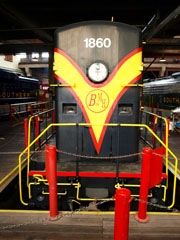
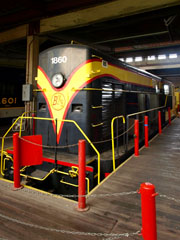
#1860 is an H-12-44 switcher, one of twenty built by the Fairbanks Morse Company of Beloit, WI, for the US Army in 1953. It served at the Sunny Point Military Ocean Terminal, NC, before moving to Beaufort & Moorehead Railroad, where it was based at Moorehead City State Ports, NC.
#1860 was acquired by the museum in 2004 after disposal by State Ports, and it has been used by the museum for on-site train rides.

Fairbanks Morse had developed a diesel engine used on much of the US Navy's WWII submarine fleet. With two pistons in each cylinder, it generated nearly twice as much power from the same number of cylinders as other engines. Taking advantage of growing railroad dieselisation, in 1944 the company introduced what was then the most powerful engine available in a diesel, the 1,000 hp FM H-10-44. A 1,200 hp FM H-12-44 was developed in 1950.
However, the radical design made the locomotives relatively difficult to maintain. Only one hundred and
ninety-five H-10-44 units were built between 1944 and 1950, all for US railroads. A further three hundred and three H-12-44s were built for US railroads between 1950 and 1961, as well as thirty by the Canadian Locomotive Company for Canadian railroads between 1951 and 1956. One unit was exported to Mexico.
Weighing 246,000 lbs and 49' 2" long, the H-12-44 had an FM 38D8 prime mover powering four Westinghouse WE362B traction motors and developing 34,000 lbs continuous tractive effort at 8.9 mph. Initially, they were slant nosed with a rear roof visor like the FM H-10-44s but, from 1952 as a cost saving exercise, these Raymond Loewy designed features were removed. From 1956, the car bodies were shortened and a deeper side skirt was fitted.
You can see SWPX FM H-12-44 #115 on the Museum of the American Railroad page of this website, and BOMX #9733 on the B&O Museum Yard page.

#2601 is a GP30, nine hundred and forty-six of which were built by EMD between 1961 and 1963 for US railroads, and two for Canadian railroads. They were all equipped with 16 cylinder 567D3 prime movers and GM D22 generators driving four GM D57 traction motors. They delivered starting tractive effort of 60,500 lbs at 25% and 50,000 lbs continuous tractive effort at 9.3 mph.
To achieve a stylistic step change for the GP30, GM turned to their Automotive Styling Center in Troy, MI, to create the characteristic hump-and-cab profile.
The hump started at the rear of the cab, encompassing air intakes for the central air system, and tapered towards the rear of the body. The design also incorporated a low, short hood. A high, short hood could be ordered, but only Norfolk & Western and Southern did so. Southern ordered one hundred and twenty units, the largest number of any railroad.
Many railroads, including the Southern, coupled four or five GP30s together to haul fast, time-limited freight trains, and the Southern continued their use until the late 1980s. Most had been retired by 1993.

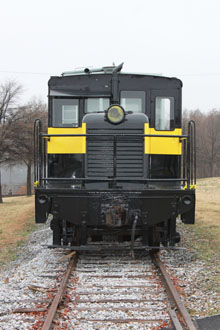
This 45 ton switcher was built by General Electric in 1943. It is equipped with two 150 hp Cummins diesel engines each driving a generator which, in turn, drives two traction motors, one per truck.
L-3 was used by the North Carolina Ports Authority in Wilmington, NC, its entire life. Donated in 1980, it is one of the oldest diesel locomotives in the museum's collection. With the help of a $2,000 heritage grant from the National Railroad Historical Society, it was recently restored by the museum to its late 1970s condition.
GE built one thousand, two hundred and ninety-nine switchers between 1931 and 1981 ranging in size from 20 tons to 132 tons. Many of the smaller units were built with this centre cab configuration.

This DE44 switcher
was built by the Davenport Locomotive Works in June 1953 for the US Army as #1223. In October 1970, it was transferred to the US Navy where it was renumbered #65-00556. The engine was moved to the museum shops
in 1990 and is sometimes used for yard work.
You can see other Davenport locomotives on the Colorado Railroad Museum, Orange Empire
Railroad Museum, Illinois Railway
Museum Yard, Ogden Union Station and Monticello Railway Museum pages of this website.


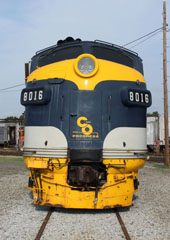
This unit was built by EMD as Clinchfield #800 in 1948. It was rebuilt in 1952 and became Seaboard System #800 in 1982. It was renumbered #116 in 1983 and then CSX #116 in 1987. In 2002 it was sold to the Chesapeake & Ohio Historical Society in Clifton Forge, VA, where it was re-liveried as Chesapeake & Ohio #8016.
The F3 was the third in EMD's F series and the second most produced in the series. EMD built
one thousand, one hundred and eleven A units
and six hundred and ninety-six cabless B units between 1945 and 1949. They were designed to haul heavy freight and have a Winton 567B 16 cylinder prime mover powering a GM D12 generator to drive four GM D17B traction motors, one on each axle. At 54' in length and weighing 258,000 lbs, they produce 40,000 lbs continuous tractive effort at 9.3 mph and have a top speed of 65 mph.
#8016 is on lease from the C&O Historical Society to the Potomac Eagle Scenic Railroad, a shortline tourist operation based in Romney, WV, that operates a little over 52 miles of an old Baltimore & Ohio Railroad branch line between Green Spring, AL, and Petersburg, TN.

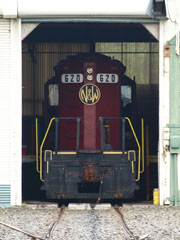
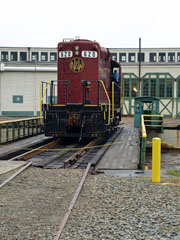


Above, NW EMD GP9 #620 noses out of one of the roundhouse stalls and onto the turntable.
#620 is one of three thousand, four hundred and forty-four GP9 units built for US railroads by EMD between 1954 and 1963. Another six hundred and forty-six were built for Canadian railroads, as well as twenty-five for other railroads in South America.
They developed 1,750 horsepower from a 16 cylinder 567C prime mover and, on the Norfolk & Western, hauled both freight, kitted out in basic black livery, and passenger trains, kitted out in N&W's signature Tuscan Red, black and gold.
Below and right, #620 stands at Barber Junction depot waiting for passengers to board the first morning excursion.
Norfolk & Western rostered a total of four hundred and sixteen GP9s. #620 was purchased by Norfolk & Western in 1958 and operated out of Roanoke, VA, to Ohio until retired in 1985, when it was donated to the museum.
Using funding from Norfolk Southern, it was painted in the N&W passenger livery and is now used for on-site train rides.
According to the museum website, #620 gets more use than any other of the museum's operational locomotives because of crew favouritism!
Related Links:
Location of the North Carolina Transportation Museu
North Carolina Museum of Transportation Website
Southern Railway Historical Association
Atlantic Coast & Seaboard Air Line Railroads Historical Society
Send a comment or query, or request permission to re-use an image.
Curt Tillotson Jr has authored four books on Southern Railway's motive power: Southern Railway Steam Trains Volume 1, Passenger; Southern Railway Steam Trains Volume 2, Freight; Southern Railway Diesel Locomotives & Trains, and Southern Railway Diesel Locomotives & Trains, 1950-1980. All four are published by TLC (click the cover to search for any of these books on Bookfinder.com).
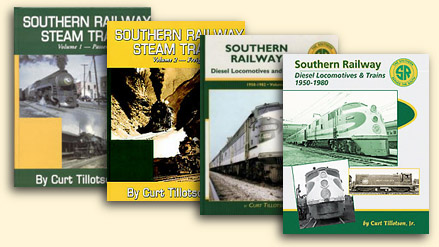
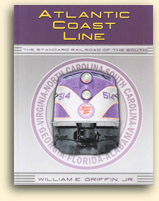
Atlantic Coast Line, by William E. Griffin Jr. is also published by TLC.
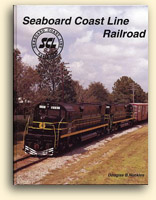
Douglas Nuckles' Seaboard Coast Line Railroad is by Motorbooks International (click the cover to search for either book on Bookfinder.com).





